
CAE Software【Femtet】Murata Software Co., Ltd.

Example16 Open Boundary (PML)
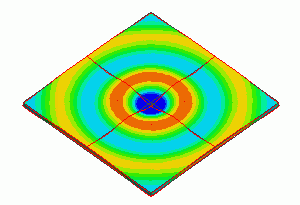
General
-
Transverse waves propagating in a piezoelectric substrate are analyzed.
-
The model is surrounded by the open boundary (PML).
-
A quarter model is analyzed.
-
Unless specified in the list below, the default conditions will be applied.
Analysis Space
|
Item |
Setting |
|
Analysis Space |
3D |
|
Model unit |
mm |
Analysis Conditions
|
Item |
Setting |
|
Solver |
Piezoelectric Analysis [Rayleigh] |
|
Analysis Type |
Harmonic Analysis |
Harmonic Analysis tab and Open Boundary tab are set as follows.
|
Tab |
Setting Item |
Setting |
|
Mesh |
General mesh size: |
1.0 |
|
Harmonic Analysis |
Sweep Values |
50×10^3[Hz] |
|
Sweep Type |
Single frequency |
|
|
Sweep Setting |
Deselect Fast sweep. |
|
|
Input |
1.0[W] |
|
|
Open Boundary |
Type |
PML |
|
PML Thickness |
0.3 [wavelength] |
|
|
PML damping coefficient |
1.0 |
|
|
Wavelength |
0.012[m] |
The wavelength is used only to decide the PML thickness. PML thickness [m] is equal to PML thickness [wavelength] multiplied by the wavelength.
The value of 0.012[m] is a reading of the analysis result. As the wavelength is unknown for the initial analysis,
it is set to 0.0[m] for the analysis. By doing so, the PML thickness is decided based on the wavelength of the longitudinal wave which is calculated from the material.
The PML thickness decided in this way tends to be thick. The calculation load can be reduced by setting the actual wavelength.
-
For your reference, see Open boundary tab and PML in the Technical Note.
Graphical Objects
Forced displacement is applied on the center of a large plate. A quarter model is analyzed.
The planes of symmetry are YZ and ZX planes.
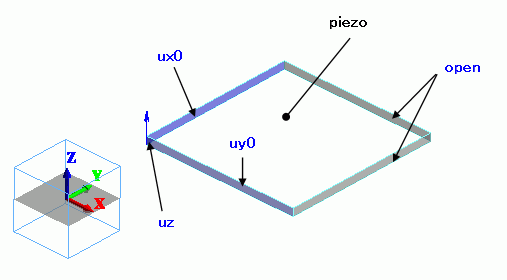
Body Attributes and Materials
|
Body Number/Type |
Body Attribute Name |
Material Name |
|
0/Solid |
piezo |
000_P-4 |
(*) Available from the Material DB
Boundary Condition
|
Boundary Condition Name/Topology |
Tab |
Boundary Condition Type |
Setting |
|
OPEN/Face |
Mechanical |
Open Boundary |
|
|
UZ/Vertex |
Mechanical |
Displacement |
1.0X10^-3 [m] in Z direction |
|
SYM_UX0/Face |
Symmetry/Continuity |
Face of symmetry |
|
|
SYM_UY0/Face |
Symmetry/Continuity |
Face of symmetry |
|
|
Outer Boundary Condition |
Mechanical |
Free |
|
|
Electric |
Magnetic wall |
Select on the open boundary tab of the analysis condition setting. |
SYM_UX0 is set with Reflective Symmetry , so it is fixed in X direction.
SYM_UY0 is also set with Reflective Symmetry , so it is fixed in Y direction.
The results of the full model can be viewed with the [Full Model] function.
Results
The contour of displacement in Z direction is shown below. Concentric acoustic waves are propagating outward. PML is hidden in Figure 1.
PML is shown in Figure 2. The displacements are damped in the PML. The wave is traveling wave.
The result is well rendered in Animation.
To zoom in to the model, “Full Model” is deselected.
The diagram below is shown in the same size of the quarter model.
-
Obtain the animation file. (Save the file before open)
To show concentric circles well in the animation, [Gradation contour with color division] is selected on the [Contour tab] of [Graphics Setup] in the Results Window.
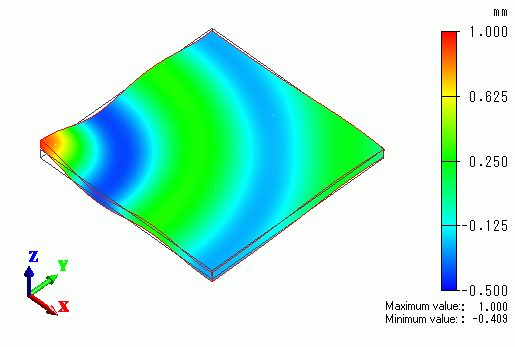
Figure 1. Contour of Z displacement with PML hidden
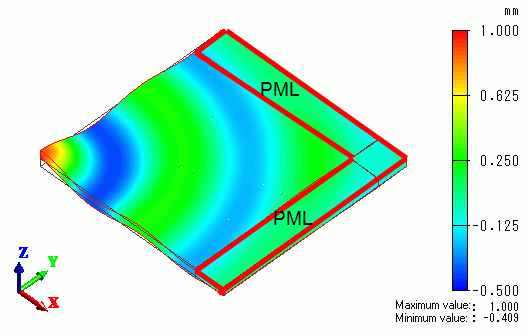
Figure 2. Contour of Z displacement with PML shown
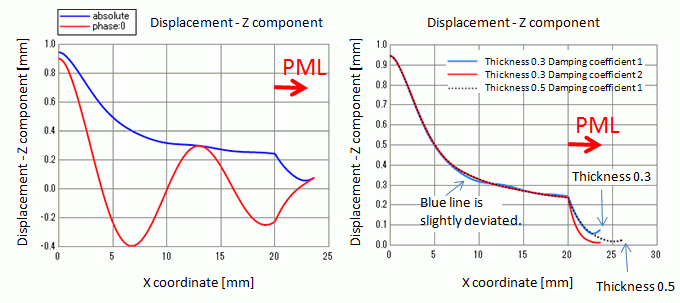
Figure 3(a). Z displacement Figure 3(b) Settings changed from Figure 3(a) (See notes below)
phase 0 and absolute effect of thickness and damping coefficient
Z component of displacement on the edge area (shown in red rectangle) in X axis direction in the Figure 2 The overlapping diagram of phase0 and absolute is shown in Figure 3(a).
absolute is damping rapidly in the PML area.
Figure 3(b) shows the effect of correcting parameters of PML. Red line is a result of damping coefficient correction from 1 to 2
Black dotted line is a result of thickness correction from 0.3 to 0.5. Except for PML area, red line and black dotted line match and they damp smoothly.
Red line is damping rapidly in the PML area as the damping coefficient is increased.
Blue line is a result without correction. It slightly deviates from other lines. It can be considered that correcting thickness and damping coefficient contribute to the characteristics improvement.
-
For your reference, see Open boundary tab and PML in the Technical Note.

